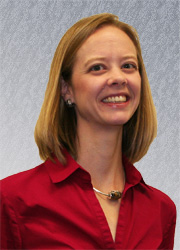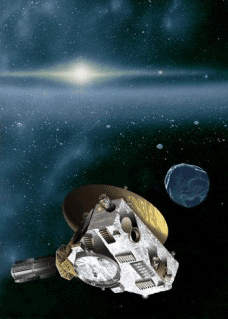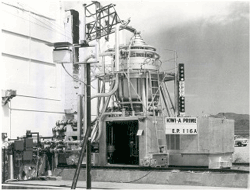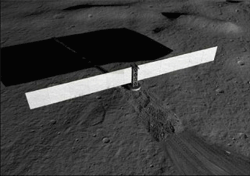Space, the final nuclear frontier: NETS-2011
From high in orbit above planet Earth... to the dusty surface of the moon... to the stunning cloud tops and moons of Jupiter... to the dazzling rings of Saturn... even to the darkness at the edge of interstellar space-nuclear technology has made possible incredible journeys to extraordinary destinations in our Solar System, and opened doors to some of the most profound discoveries of all time. Yet, the future of nuclear technology for space exploration promises even more remarkable journeys and more amazing discoveries.

The Mars Science Laboratory is powered by nuclear technology and scheduled for Mars landing in August 2012.
The 2011 Nuclear and Emerging Technologies for Space conference (NETS-2011), to be held at the Albuquerque Marriott Hotel in New Mexico on February 7-10, 2011, will bring together top engineers, scientists, and administrators in nuclear and aerospace technologies to share their latest discoveries and advances in their fields, and to help build the future of space exploration. NETS-2011 is the foremost conference for advanced power and propulsion for human and robotic space exploration, lunar and planetary surface exploration, and space environment protection.
NETS-2011 is sponsored and organized by the Aerospace Nuclear Science & Technology Division (ANSTD) of the American Nuclear Society (ANS), sponsored by the ANS Trinity Section, and cosponsored by the American Institute of Aeronautics and Astronautics (AIAA).
A unique venue for information exchange and collaboration

Bragg-Sitton
Nuclear and aerospace are related, but often disparate fields. "ANS tends to attract nuclear engineers to its meetings, and AIAA tends to attract aerospace engineers to theirs," said Shannon Bragg-Sitton, Ph.D., general chair of NETS-2011. "What is unique about the NETS-2011 venue is that papers are presented not only by engineers designing space power and propulsion systems, but also those completing mission planning and analysis for proposed space missions, and sometimes scientists who are designing payloads for those missions."
Benefits flow both ways among nuclear professionals and mission designers. "The NETS-2011 venue allows nuclear professionals to hear about missions that require high-power or advanced propulsion systems-and conversely, it allows mission designers to learn more about what advanced power and propulsion systems, such as nuclear systems, are available, or that could be developed, to meet the needs of those missions," said Bragg-Sitton. "Establishing these lines of communication-and then working to keep them open through collaborative work-will more rapidly advance technology development, as it will be developed to specifically meet the needs of the user community."

The Cassini Equinox Mission is powered by nuclear technology and is currently studying Saturn, its moon Titan, and other satellites.
To that end, the promise of nuclear and emerging technologies for upcoming NASA space science, missions, and architectures will be the subject of many technical sessions at NETS-2011, and addressed by opening plenary keynote speakers Honorary Chair John Casani, NASA Jet Propulsion Laboratory, and Jim Adams, deputy director, Planetary Science Division, NASA Headquarters. An opening day plenary panel on space science missions enabled by nuclear power and propulsion will be led by chair Steve Howe, director of the Center for Space Nuclear Research.
Bragg-Sitton notes: "At standard professional society meetings, telling other nuclear professionals about the benefits of nuclear technology does not solve the problem of "getting the word out" to potential users of the technology-NETS-2011 does just that."
Radioisotope power

The New Horizons Mission spacecraft, powered by a radioisotope thermoelectric generator battery, will encounter Pluto and its three moons in July 2015.
Radioisotope power generators, which convert heat from a radioactive substance into electricity, have powered (and kept warm) dozens of historic space exploration missions, as well as current missions focusing on more distant planets and their moons, and the upcoming surface exploration of Mars. Radioisotope power will continue to be the mainstay power source for space exploration in harsh, cold, and dark environments-however, future goals will require new technologies, using new materials, more efficient and lighter systems, at reasonable cost. Robert Lange, deputy assistant secretary for Business and Technical Support, U.S. Department of Energy, in the opening plenary will discuss the status and future of radioisotope power for space.
This critical technology will also be the subject of many technical sessions at NETS-2011, as well as a panel session on the critical issue of the dwindling supply and production of plutonium-238-the historically unanimous isotope choice for nuclear spacecraft power.
Fission power, fission propulsion
Nuclear fission provides some enormous advantages over chemical and traditional systems for spacecraft power, surface exploration, and spacecraft propulsion. Nuclear fission for space is not a new field, as the United States launched the SNAP-10a fission reactor into orbit in 1965, and the Soviet Union deployed more than two dozen nuclear reactors in orbit on naval monitoring satellites during the Cold War.

A KIWI design prime nuclear thermal rocket engine was built and tested in the 1960s.
While those fission systems were used for spacecraft power, many nuclear thermal fission reactors for space propulsion were also successfully built and ground tested, and by the 1970s development had progressed essentially to the point of flight prototypes. NETS-2011 Honorary Chair Harry Finger, retired, Atomic Energy Commission and NASA (as well as key positions in other agencies), is featured in the opening plenary session to discuss why these early space fission programs were so successful-and will offer some suggestions as to how we might recapture that success and move forward more quickly in current programs.

A proposed lunar surface fission reactor would use lunar soil for secondary reactor shielding.
Research, development, and testing of fission reactors for spacecraft and surface power, and spacecraft propulsion, continues to the present day. These nuclear technologies, which can bring the advantages of fission directly into space, will be the subject of an invited panel session and numerous technical sessions at NETS-2011.
Advanced concepts
Advanced technologies, including fusion and other very high energy sources of power and propulsion, may someday prove essential to meet, or set, challenging space exploration goals. Technical sessions at NETS-2011 will explore some of these impressive possibilities.
Navigating the worlds of politics and policy
A special session on nontechnical challenges for nuclear and emerging technologies for space, chaired by former NASA Administrator Michael Griffin, features numerous top policy makers and administrators, and promises to be a highlight of NETS-2011. "I am particularly excited about the special session, as it will present a different perspective than typical technical sessions," said Bragg-Sitton. "There have been a number of programs to develop radioisotope and fission systems in the past, some of which have led to flight systems. However, space nuclear systems development often suffers greatly from fluctuating funds and political cycles."
The goal of this special session will be to assist implementation of space nuclear systems and other technologies to completion, by identifying nontechnical challenges to space nuclear systems, their causes, possible solutions, and possible implementation strategies.
Bragg-Sitton notes: "Long-range planning and sustainable funding will go far in developing advanced power and propulsion systems. These long-term issues are often political in nature, which is why we have planned a nontechnical special session on the challenges facing the continued development of nuclear technologies for space."

Click to Enlarge
Distinguished presenters to address conference
Conference participants will enjoy two highly distinguished dinner key speakers: Glen Schmidt, retired, former test engineer for the SNAP-10a space fission program, and Harrison "Jack" Schmitt, Apollo 17 astronaut and former U.S. senator.
Registration and other information can be found in the NETS-2011 meeting program. About 200 participants are expected, and 89 technical papers are scheduled for presentation.
Exhibitors at NETS-2011: Center for Space Nuclear Research, Hamilton Sundstrand, Idaho National Laboratory, Los Alamos National Laboratory, Lockheed Martin, NASA Glenn Research Center, NASA Marshall Space Flight Center, Sandia National Laboratories, University of Leicester.
Contact: Shannon Bragg-Sitton, general chair NETS-2011, chair of ANSTD at ANS.

Paul Bowersox is a space exploration enthusiast and freelance writer who holds a master's degree in public policy. He is a freelance writer living in Ohio.
He is a guest contributor to the ANS Nuclear Cafe.









